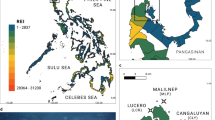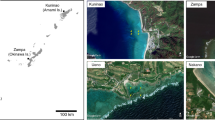Abstract
The philopatric larval dispesal and small effective population sizes characteristic of many clonal species should promote the development of significant small-scale genetic structure within populations as a result of isolation-by-distance. We used spatial autocorrelation statistics to detect genetic structure, arising from both clonal reproduction and philopatric dispersal of sexual propagules, for five allozyme loci within populations of the soft coral Alcyonium sp. In a population on Tatoosh Island, Washington, USA, sampled in 1991/1992, we found significant positive spatial autocorrelation at all loci among individuals separated by <40 cm, reflecting the presence of significant smallscale genetic structure due to associations among clonemates. For 4 of 5 loci, however, we detected no significant spatial autocorrelation among the different clones within this population over distances of 1 to 40 m. Analysis of soft-coral populations from six additional, topographically diverse sites in the north-east Pacific also did not reveal significant spatial autocorrelation among clones at any loci. This general lack of spatial autocorrelation of genotypes among clones suggests that significant small-scale genetic structure has not arisen in populations of Alcyonium sp. as a consequence of isolation-by-distance.
Similar content being viewed by others
References
Argyres AZ, Schmitt J (1991) Microgeographic genetic structure of morphological and life history traits in a natural population of Impatiens capensis. Evolution 45: 178–189
Ayre DJ (1984) The effects of sexual and asexual reproduction on geographic variation in the sea anemone Actinia tenebrosa. Oecologia 62: 222–229
Ayre DJ (1988) Evidence for genetic determination of sex in Actinia tenebrosa. J exp mar Biol Ecol 116: 23–43
Ayre DJ, Dufty S (1994) Evidence for restricted gene flow in the viviparous coral Seriatopora hystrix on Australia's Great Barrier Reef. Evolution 48: 1183–1201
Ayre DJ, Read J, Wishart J (1991) Genetic subdivision within the eastern Australian population of the sea anemone Actinia tenebrosa. Mar Biol 109: 379–390
Ayre DJ, Resing JM (1986) Sexual and asexual production of planulae in reef corals. Mar Biol 90: 187–190
Babcock RC (1991) Comparative demography of three species of scleractinian corals using age-and size-dependent classifications. Ecol Monogr 61: 225–244
Berg EE, Hamrick JL (1985) Fine-scale genetic structure of a Turkey oak forest. Evolution 49: 110–120
Black R, Johnson MS (1979) Asexual viviparity and population genetics of Actinia tenebroasa. Mar Biol 53: 27–31
Brazeau DA, Harvell CD (1994) Genetic structure of local populations and divergence between growth forms in a clonal invertebrate, the Caribbean octocoral Briareum asbestinum. Mar Biol 119: 53–60
Brazeau DA, Lasker HR (1992) Reproductive success in the Caribbean octocoral Briareum asbestinum. Mar Biol 114: 157–163
Burnett WJ, Benzie JAH, Beardmore JA, Ryland JS (1995) Patterns of genetic subdivision in populations of a clonal cnidarian, Zoanthus coppingeri, from the Great Barrier Reef. Mar Biol 122: 665–673
Cliff AD, Ord JK (1981) Spatial processes. Pion Ltd., London
Coates DJ (1992) Genetic consequences of a bottleneck and spatial genetic structure in the triggerplant Stylidium coroniforme (Stylidiaceae). Heredity, Lond 69: 512–520
Coffroth MA, Lasker HR, Diamond ME, Bruenn JA, Bermingham E (1992) DNA fingerprints of a gorgonian coral: a method for detecting clonal structure in a vegetative species. Mar Biol 114: 317–325
Crawford TJ (1984) What is a population? In: Shorrocks B (ed) Evolutionary ecology. Blackwell Scientific Publications, Oxford, pp 135–173
Denny MW (1988) Biology and the mechanics of the wave-swept environment. Princeton University Press, Princeton, New Jersey
Denny MW, Shibata MF (1989) Consequences of surf-zone turbulence for settlement and external fertilization. Am Nat 134: 859–889
Dewey SE, Heywood JS (1988) Spatial genetic structure in a population of Psychotria nervosa. I. Distribution of genotypes. Evolution 42: 834–838
Endler JA (1977) Geographic variation, speciation, and clines. Princeton University Press, Princeton, New Jersey
Epperson BK (1989) Spatial patterns of genetic variation within plant populations. In: Brown AHD, Clegg MT, Kahler AL, Weir BS (eds) Plant population genetics, breeding, and genetic resources. Sinauer Associates, Sunderland, Mass, pp 229–253
Epperson BK (1990) Spatial autocorrelation of genotypes under directional selection. Genetics, Austin, Tex 124: 757–771
Epperson BK (1995) Spatial distribution of genotypes under isolation by distance. Genetics, Austin, Tex 140: 1431–1440
Epperson BK, Allard RW (1989) Spatial autocorrelation analysis of the distribution of genotypes within populations of lodgepole pine. Genetics, Austin, Tex 121: 369–377
Epperson BK, Clegg MT (1986) Spatial-autocorrelation analysis of flower color polymorphisms within substructured populations of morning glory (Ipomoea purpurea). Am Nat 128: 840–858
Gabriel KR, Sokal RR (1969) A new statistical approach to geographic variation analysis. Syst Zool 18: 259–270
Gerrodette T (1981) Dispersal of the solitary coral Balanophyllia elegans by demersal planular larvae. Ecology 62: 611–619
Grosberg RK (1991) Sperm-mediated gene flow and the genetic structure of a population of the colonial ascidian Botryllus schlosseri. Evolution 45: 130–142
Hartl DL, Clark AG (1988) Principles of population genetics. 2nd edn. Sinauer Associates Inc. Sunderland, Mass
Hellberg ME (1995) Stepping-stone gene flow in the solitary coral Balanophyllia elegans: equilibrium and nonequilibrium at different spatial scales. Mar Biol 123: 573–581
Hoffmann RJ (1986) Variation in contributions of asexual reproduction to the genetic structure of populations of the sea anemone Metridium senile. Evolution 40: 357–365
Hughes TP, Ayre D, Connell JH (1992) The evolutionary ecology of corals. Trends Ecol Evolut 7: 292–295
Hunter CL (1993) Genotypic variation and clonal structure in coral populations with different disturbance histories. Evolution 47: 1213–1228
Jackson JBC (1985) Distribution and ecology of clonal and aclonal benthic invertebrates. In: Jackson JBC, Buss LW, Cook RE (eds) Population biology and evolution of clonal organisms. Yale University Press, New Haven, pp 297–355
Jackson JBC (1986) Modes of dispersal of clonal benthic invertebrates: consequences for species distributions and genetic structure of local populations. Bull mar Sci 39: 588–606
Jackson JBC, Coates AG (1986) Life cycles and evolution of clonal (modular) animals. Phil Trans R Soc (Ser B) 313: 7–22
Jokiel PL (1984) Long distance dispersal of reef corals by rafting. Coral Reefs 3: 113–116
Knowlton N, Jackson JBC (1993) Inbreeding and outbreeding in marine invertebrates. In: Thornhill N (ed) The natural history of inbreeding and outbreeding. University of Chicago Press, Chicago, pp 200–249
Levitan DR (1991) Influence of body size and population density on fertilization success and reproductive output in a free-spawning invertebrate. Biol Bull mar biol Lab, Woods Hole 181: 261–268
Li CC, Horvitz DG (1953) Some methods of estimating the inbreeding coefficient. Am J hum Genet 5: 107–117
Mayr E (1970) Populations, species, and evolution. Harvard University Press, Cambridge, Mass
McFadden CS (1986) Colony fission increases particle capture rates of a soft coral: advantages of being a small colony. J exp mar Biol Ecol 103: 1–20
McFadden CS (1991) A comparative demographic analysis of clonal reproduction in a temperate soft coral. Ecology 72: 1849–1866
McFadden CS (1996) A genetic analysis of clonal reproduction in a temperate soft coral: can population genetic structure be predicted from clonal demography? (In preparation)
Mladenov PV, Emson RH (1988) Density, size structure and reproductive characteristics of fissiparous brittle stars in algae and sponges: evidence for interpopulational variation in levels of sexual and asexual reproduction. Mar Ecol Prog Ser 42: 181–194
Pennington JT (1985) The ecology of fertilization of echinoid eggs: the consequences of sperm dilution, adult aggregation, and synchronous spawning. Biol Bull mar biol Lab, Woods Hole 169: 417–430
Perry DJ, Knowles P (1991) Spatial genetic structure within three sugar maple (Acer saccharum Marsh.) stands. Heredity, Lond 66: 137–142
Potts DC (1984) Generation times and the Quaternary evolution of reef-building corals. Paleobiology 10: 48–58
Potts DC, Done TJ, Isdale PJ, Fisk DA (1985) Dominance of a coral community by the genus Porites (Scleractinia). Mar Ecol Prog Ser 23: 79–84
Schnabel A, Laushmann RH, Hamrick JL (1991) Comparative genetic structure of two co-occurring tree species, Maclura pomifera (Moraceae) and Gleditsia triacanthos (Leguminosae). Heredity, Lond 67: 357–364
Schoen DJ, Latta RG (1989) Spatial autocorrelation of genotypes in populations of Impatients pallida and Impatiens capensis. Heredity, Lond 63: 181–189
Shapcott A (1995) The spatial genetic structure in natural populations of the Australian temperate rainforest tree Atherosperma moschatum (Labill.) (Monimiaceae). Heredity, Lond 74: 28–38
Shick JM, Lamb AN (1977) Asexual reproduction and genetic population structure in the colonizing sea anemone Haliplanella luciae. Biol Bull mar biol Lab, Woods Hole 153: 604–617
Sokal RR (1979) Ecological parameters inferred from spatial correlograms. In: Patil GP, Rosenzweig ML (eds) Contemporary quantitative ecology and related ecometrics. International Cooperative Publishing House, Fairland, Md, pp 167–196
Sokal RR, Jacquez GM, Wooten MC (1989) Spatial autocorrelation analysis of migration and selection. Genetics, Austin, Tex 121: 845–855
Sokal RR, Oden NL (1978a) Spatial autocorrelation in biology. I. Methodology. Biol J Linn Soc 10: 199–228
Sokal RR, Oden NL (1978b) Spatial autocorrelation in biology. II. Some biological implications and four applications of evolutionary and ecological interest. Biol J Linn Soc 10: 229–249
Sokal RR, Wartenberg DE (1983) A test of spatial autocorrelation analysis using an isolation-by-distance model. Genetics, Austin, Tex 105: 219–237
Stoddart JA (1983) Asexual production of planulae in the coral Pocillopora damicornis. Mar Biol 76: 279–284
Stoddart JA (1984a) Genetical structure within populations of the coral Pocillopora damicornis. Mar Biol 81: 19–30
Stoddart JA (1984b) Genetic differentiation amongst populations of the coral Pocillopora damicornis off southwestern Australia. Coral Reefs 3: 149–156
Stoddart JA (1988) Historecognition and fine-scale spatial genetic structure in sessile benthic invertebrates. In: Grosberg RK, Hedgecock D, Nelson K (eds) Invertebrate historecognition. Plenum Publishing Corp, New York, pp 111–125
Swofford DL, Selander RB (1981) BIOSYS-1: a computer program for the analysis of allelic variation in genetics. University of Illinois at Urbana-Champagne, Urbana, Illinois
Turner ME, Stephens JC, Anderson WW (1982) Homozygosity and patch structure in plant populations as a result of nearestneighbor pollination. Proc natn Acad Sci USA 79: 203–207
Waser NM (1987) Spatial genetic heterogeneity in a population of the montane perennial plant Delphinium nelsonii. Heredity, Lond 58: 249–256
Weir BS (1990) Intraspecific differentiation. In: Hillis DM, Moritz C (eds) Molecular systematics. Sinauer Associates, Sunderland, Mass, pp 373–410
Weir BS, Cockerham CC (1984) Estimating F-statistics for the analysis of population structure. Evolution 38: 1358–1370
Williams CF (1994) Genetic consequences of seed dispersal in three sympatric forest herbs. II. Microspatial genetic structure within populations. Evolution 48: 1959–1972
Wright S (1943) Isolation by distance. Genetics, Princeton 28: 114–138
Wright S (1946) Isolation by distance under diverse systems of mating. Genetics, Princeton 31: 39–59
Wright S (1951) The genetical structure of populations. Ann Eugen 15: 323–354
Wright S (1965) The interpretation of population structure by F-statistics with special regard to systems of mating. Evolution 19: 395–420
Wright S (1969) Evolution and the genetics of populations, Vol 2. The theory of gene frequencies. University of Chicago Press, Chicago
Yund PO (1990) An in situ measurement of sperm dispersal in a colonial marine hydroid. J exp Zool 253: 102–106
Author information
Authors and Affiliations
Additional information
Communicated by M. F. Strathmann, Friday Harbor
Rights and permissions
About this article
Cite this article
McFadden, C.S., Aydin, K.Y. Spatial autocorrelation analysis of small-scale genetic structure in a clonal soft coral with limited larval dispersal. Marine Biology 126, 215–224 (1996). https://doi.org/10.1007/BF00347446
Received:
Accepted:
Issue Date:
DOI: https://doi.org/10.1007/BF00347446




